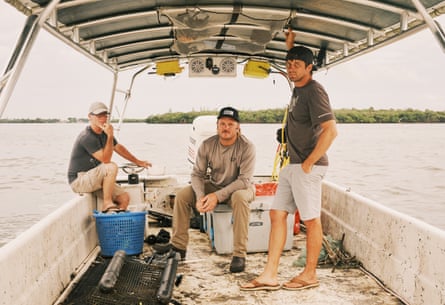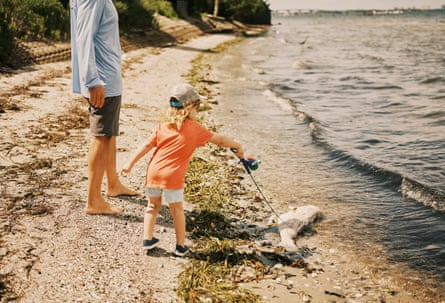Hundreds of tons of dead marine life have washed ashore and wafted a putrid stench along Florida’s beaches in recent weeks amid a toxic red tide bloom spreading in its waters.
Thomas Patarek lives just a half mile away from the waterway.
“When I walk my dog in the morning, I can smell the dead fish,” he told the Guardian. “I can feel the red tide in my throat.”
While red tides occur naturally in the Gulf of Mexico, experts feared a large bloom was imminent after a toxic breach at the Piney Point phosphate plant in late May. In order to prevent a devastating collapse of the site’s reservoir - which held some 480 million gallons of wastewater - state officials pumped wastewater out of the reservoir and into storage containers and a local seaport, according to the Tampa Bay Times. On Thursday, the state’s environmental agency filed a lawsuit against the former phosphate mining facility’s owner over the breach. “Today, the department took a pivotal step to ensure this is the final chapter for the Piney Point site,” according to a statement by the agency’s secretary.

The massive spill threatened nearby residents with a 20-foot wall of water and led to the evacuation of nearby residents and businesses. Experts now believe the wastewater that was dumped into Port Manatee, which leads into Tampa Bay, could be supplying a buffet of nutrients for bacteria to feast on, which could have caused the algae bloom. Warming waters due to climate change are also making red tides worse, according to experts.
Paterek is the chair of Suncoast Surfrider – a nonprofit that works to protect the state’s oceans and beaches. Earlier this month, he received a frantic call from a friend and local paddle boarding business owner who was in tears over the sight of dead fish on the beach.
A community rallied around that cry, but a coordinated state response has been slow. So far, the state has given $1m towards cleanup efforts for the fish killed by the red tide. Patarek and his group organized a protest calling for the state’s governor, Republican Ron DeSantis, to declare a state of emergency that would free up more resources to clean up the fish-clogged bay. The city council of St. Petersburg, one of the areas hardest hit by the scourge, also pushed for a state of emergency declaration to coordinate a state and federal response.

DeSantis has not been receptive to their appeals. While the governor argues that declaring a state of emergency would hurt tourism across the state, residents have been left to deal with the damage, and argue that the algae bloom is a massive ecological crisis that could have been avoided.
“We need a stronger response, so that we can function. It’s a quality of life issue,” Patarek said. “We have commercial fishermen, business owners and people that live near the water that say they’ve never seen anything like this.”
Curt Hemmel founded Bay Shellfish Company, Florida’s largest bivalve hatchery, in 1996. “Based on our 25 years experience in the area, and knowing how red tide acts in Tampa Bay, I feel completely confident that the current red tide bloom is more excessive thanks to Piney Point,” Hemmel said, adding that red tide blooms almost never happen this early in the summer.
In June, scientists and state environmental officials downplayed the severity of the red tide and its link to the spill. “I don’t think that the red tide originated as a consequence of Piney Point,” Tom Frazer, Florida’s former chief science officer, said in a roundtable held by the governor. The state’s press release recapping the discussion made no mention of the Piney Point spill.
But some residents argue the state failed to prevent the disaster at Piney Point that caused or at the very least intensified the harmful algal bloom – and it’s not stepping up to prevent the next.
“For people that have lived in this area for 30, 40, 50 years, they’ve all said this is the worst red tide they’ve ever experienced. We knew what this spill would have done if it wasn’t properly cleaned and managed,” said Patarek. “We know [wastewater] fuels harmful algal blooms. What we’re mostly frustrated at is the prevention aspect and we’re hoping for someone on the state level to step it up, and hold these corporate polluters responsible.”
“If we continue to have outbreaks of red tide, that’s certainly going to have a major impact on Florida’s economy and the wellbeing of coastal communities,” said Glenn Compton of Mana-Sota 88, an environmental watchdog critical of the phosphate industry.

The fish kills are occurring in one of the most sensitive and productive marine habitats in the state, which is home to several threatened and endangered species: Bishop Harbor, which is part of the Terra Ceia Aquatic Buffer Preserve. While the dead fish have largely been cleaned up thanks to local community efforts, Compton said “the [government’s] response is pretty much underwhelming.”
Earlier this month, conservation groups sued the governor and other Florida regulators, hoping to take the state to task. The lawsuit argues that Piney Point is an ongoing threat to public health as well as a threat to marine ecosystems and protected species. The groups asked a federal judge to oversee the cleanup, closure and investigation of the plant. “The Piney Point disaster is Exhibit A in a long list of Florida’s failures to protect our water and wildlife from the harms of phosphogypsum,” Jaclyn Lopez of the Center for Biological Diversity said in a press release.
Algae produce toxins that kill fish and other marine life, leaving fishermen without work and fishing stores without customers. In mid-July, with hordes of dead fish piling up on shores, the state imposed restrictions on fishing redfish, trout and snook. The new guidelines came just months after the state had lifted fishing limits established in 2018, during the last large algal bloom.
These restrictions – which instruct recreational fishers and anglers to catch and release these iconic fish species – are intended to limit the impact from the outbreak and keep fisheries in business throughout red tide events.
But Hemmel says these measures are not enough to keep the fishing industry, which is already hurting, afloat. Instead, he says, “The governor could declare this red tide an environmental emergency and free up funds for people hurt by the event. Certainly, the farming and fishing community would like to see that.”
Hemmel said his shellfish business can still produce products through its hatchery, but other animals, such as bay scallops, died quickly thanks to the Frankenstein red tide. “All shellfish species that are farmed, [we’ve] been unable to harvest,” he told the Guardian, adding that he believes the red tide “created a negative impact for our other shellfish production, as small shellfish are ultra sensitive to environmental status.”
The local business owner fears this year’s bloom will be similar to 2018, when a massive red tide spread along southwestern Florida, killing marine life and costing businesses millions of dollars in lost tourism dollars. “It was the worst tide ever. We were practically closed all year because of it,” Hemmel said.

The Piney Point phosphate plant remains an ecological threat as well. There are still hundreds of millions of gallons of phosphate mining wastewater contained on site that could run off into Florida’s waters, according to Justin Bloom from Suncoast Waterkeepers, a nonprofit dedicated to protecting Florida’s waterways.
For now, the red tide persists; the state’s most recent sampling data shows high levels of the bacteria that causes the bloom. “We’re in for a hard summer. I expect that it’ll get a lot worse before it gets any better,” said Compton.
